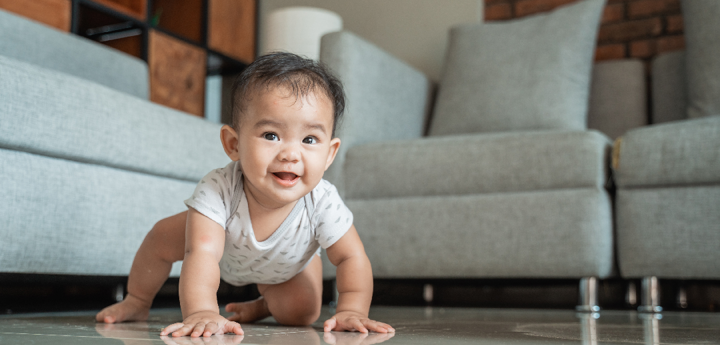Learning to move
- 0-1 Years
- Child development and growing up
- Moving and being active

Babies are limited in the amount they can move. They're strengthening their muscles with small movements throughout the day.
Many parents worry about their babies developing flat head syndrome. Babies spend a lot of time sleeping and travelling on their back. It is important for babies to move around during the day. Encouraging your baby to play on their side or tummy can help prevent them developing a flat head.
Explore the topics in this page:
Creating a soft safe space
Baby gyms and playmats are not essential for your child's development. They can be helpful and give a sense of comfort to you as the parent. However, you can create a soft safe space for your baby at home using every day items from your home. You do not have to buy a baby gym.
Remember whilst it is a safe space for your baby, your baby will need to be supervised at all time.
You will need:
- a flat stable surface like the floor away from stairs and bookcases
- a soft surface like a play mat, yoga mats or blanket
- a baby fence or baby gate
Set up:
- Place your playmat, yoga mat or blanket on the floor. Set up a boundary using the baby fence or baby gate.
- Avoid placing your baby on a sofa or bed as they can easily roll off and hurt themselves.
- Keep the space free from sharp, small and easy to swallow objects.
- Try not to put all your baby's toys in with them. Give them 2 to 3 toys at time and change them out for new toys regularly. This gives them some variety.
On their back
As your baby will be on their back for most of the day. It is important to encourage them to reach and grasp as this helps build their muscles.
Things to do whilst your baby is lying on their back in your lap:
- encourage your baby to move their hands together or to touch your face, hands, or clothes
- introduce a soft toy for them to explore and play with
Things to do whilst your baby is lying on their back on the floor:
- encourage them to reach, grasp and play with both hands
- create a soft safe space so they can reach for the toys
- encourage them to look at you
Tummy time
Tummy time is when you place your baby on their stomach whilst your baby is awake, alert, and happy. It helps babies to develop control in their neck, arms, and back muscles. Your baby needs these muscles for sitting and crawling.
It is recommended that from birth, babies are on their tummies to play. The earlier your baby is in this position, the less likely they are to dislike it. They are more likely to realise that it's a great position to play in.
Tummy time is not limited to having your baby on their tummy on the floor or a playmat. There is more than one way for your baby to have tummy time. There are many different ways to have tummy time:
-
- placing your baby on their tummy on the floor or on a playmat
- holding your baby on your chest
- holding over your shoulder facing you
Being on their stomach can encourage your baby to roll over and get a different view of the world. The variety of positions your baby lies in can help prevent head flattening.

Things to remember when having tummy time with your baby:
Do not leave your baby unsupervised. Always stay with your baby during tummy time.
Start with several short periods of tummy time every day (a few minutes to start with). Gradually build up the length of tummy time.
Try not to put your baby on their tummy just after they have been fed. This will be uncomfortable for your baby.
Tuck your baby’s elbows under their shoulders.
Some babies don’t like being on their tummies and this is completely normal. You baby may change their mind as they develop week by week. Do not worry if your baby doesn’t like tummy time. Your baby will start to enjoy being on their tummy with lots of practice and praise.
Learning to roll
Rolling is one of the first experiences of your baby moving their entire body. It helps babies to learn how to control the muscles used for sitting and standing. It also helps them build their balance and spatial awareness skills.
You can expect your baby to learn to roll by themselves.
Need more support for your child?
If your child needs further support developing their early physical skills, read our activities to support your baby's movement.
Last reviewed: 1 November, 2023




